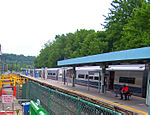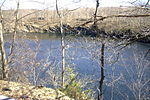Brewster station

Brewster station is a commuter rail stop on the Metro-North Railroad's Harlem Line, located in Brewster, New York. It is the southernmost station in Putnam County. Trains leave for New York City every hour, and about every 25 minutes during rush hour. It is 52 miles (83.7 km) from Grand Central Terminal and travel time there is approximately one hour, 22 minutes. The station is located in the Zone 7 Metro-North fare zone. A sizable amount of the station's ridership comes from across the Connecticut state line given the quicker trips, shorter headways, and (outside peak hours) lack of a mid-trip transfer to Grand Central as opposed to taking the Danbury Branch of the New Haven Line. Because of this, Housatonic Area Regional Transit (the Greater Danbury-area mass transit provider) has a route and a shuttle connecting Danbury to Brewster station.
Excerpt from the Wikipedia article Brewster station (License: CC BY-SA 3.0, Authors, Images).Brewster station
Railroad Avenue, Town of Southeast
Geographical coordinates (GPS) Address External links Nearby Places Show on map
Geographical coordinates (GPS)
| Latitude | Longitude |
|---|---|
| N 41.3947 ° | E -73.6198 ° |
Address
Brewster
Railroad Avenue 401
10509 Town of Southeast
New York, United States
Open on Google Maps






